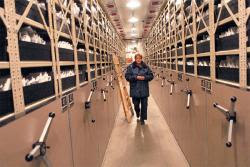 |
| Government Seed Bank |
On the CSU Campus, there is a storage facility for seeds that is described as “insurance against global change.” It houses billions of seeds under the auspices of a Fort Collins division called The National Center For Genetic Resource Preservation.
William Engdahl has even written about a Doomsday Seed Vault in the Artic where, “Bill Gates is investing tens of his millions along with the Rockefeller Foundation, Monsanto Corporation, Syngenta Foundation and the Government of Norway.”
If the governments and Elites of the world are taking seed protection so seriously, then it behooves the individual to develop a similar seed bank savings account that can offer real value in a world where traditional currency continues to show weakness and pressure. By saving your own seeds, you can take part in evolution, as well as increase your self-sufficiency.
Before the rise of commercial seed giants like Monsanto, local gardeners were adept at selecting seeds from the healthiest plants, saving them, and introducing them to the harvest for the following year, thus strengthening the species. Through local adaptation to pests, genetic diversity was further ensured; it was long-term thinking at its finest.
Farmers are the pillars of rural living, even though their endeavors have been corrupted in tandem with America’s short-attention-span consumer who has been encouraged to forget their own history. However, there has been a recent revolution among farmers across the globe . . . and abject poverty does not seem to influence their mission. Even Haiti, despite their natural disaster and the worst general poverty imaginable, has rejected Monsanto’s “gift.” They know it is a Trojan Horse of the worst kind.
Seed prices still seem low enough for most people to buy packages at their local nursery, but the consumer must be aware that the quality of mass-produced and genetically modified seeds is akin to mass produced food these days: you had better know its provenance. Many of these genetically modified seeds are deliberately engineered by Monsanto not to germinate when the seeds of the mature fruit are re-planted. Seed cultivation and storage is not an area that is tailor-made for fast and cheap. However, with some basic knowledge, patience, and dedication, food independence is attainable.
In nature, the strongest harvests will come from the land where the species has proven its worth against the elements specific to that area. The resulting harvest will generally be much more bountiful and enduring than what a standardized package of seeds can provide. That said, there are some basics to know in order to insure that personal seed production and storage result in a growing savings account. The guide below provides a very general overview — seed production and storage contain many variables based on climate, plant or flower type, number of crops, and area biodiversity.
- Pollination methods — There are three methods to take into consideration: air-borne, insect, and self. Of these, self-pollinated crops offer the best opportunity for seed saving; to avoid cross pollination, it is necessary to separate varieties by a few rows of another crop.
- Root crops — Not all garden plants produce their seed at the end of the growing season. It may be necessary to dig the roots in Fall to obtain seed, then store and re-plant when weather permits.
- Hybrids — Hybrids result from a deliberate cross between inbred lines. Although popular for vegetables, due to being more vigorous and uniform, hybrids can be a disappointment for a gardener who has unknowingly planted a hybrid. Only the person who controls the original parents can produce the hybrid seed.
- Harvesting — Seed is extracted from fruit after it ripens, but before it rots. Separate the seed from its pulp and dry at room temperature. Leave pod crops on the vine until the pod dries. Harvest before the seed is dispersed.
- Storage — Once the seed is dried, gently hand rub to rid it of any chaff, then store it in an envelope in a cool, dry, rodent-free location. The seed will germinate best the following year. It is best to re-plant every year and select the best plants for seed.
There has never been a better time to re-connect with nature and your local community. The giants of GMO are engineering servitude to their inferior products. As the global financial crisis continues to produce additional dependence and insecurity, a seed savings program is a wonderfully productive solution that will pay dividends year after year.
RELATED ARTICLES:
Mimicking Nature to Feed the Masses
10 Reasons to Become Self-Sufficient and 10 Ways to Get There
GET YOUR OWN HEIRLOOM SEED BANK
RECOMMENDED BOOK FOR OVERALL PREPARATION:
Dare to Prepare, by Holly Deyo


Be the first to comment on "The Government Has a Seed Bank Savings Account — Why Shouldn’t You?"